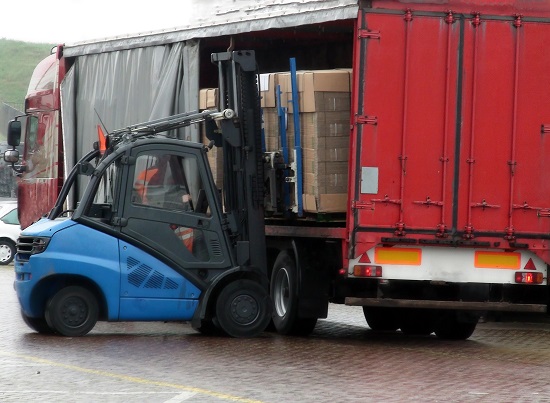An official website of the United States government
 United States Department of Labor
United States Department of Labor
| July 2015
David May has been a truck driver for more than 30 years. And in all that time, he’s never worried about finding a job. “If you’re a good driver, everybody wants you,” he says.
Truck drivers account for about 1 of every 5 jobs in the transportation and warehousing industry, according to the U.S. Bureau of Labor Statistics (BLS). But this industry employs workers in many other occupations, too, such as ship captains, cargo and freight agents, and avionics technicians.

And as these workers know, there are lots of reasons to consider a career in this industry. “I’m not sure people realize the opportunity that is here,” says Gary Statler, managing director of safety, regulatory compliance, and human resources for a marine transportation company in Pittsburgh, Pennsylvania. “These jobs are not something that can be outsourced overseas. This is a good industry to be in.”
This article describes careers in transportation and warehousing. There’s an overview of the industry and some of the occupations in it. It also includes some pros and cons associated with the work, along with tips for starting a career.
Every day, people and goods move throughout the United States. Workers in the transportation and warehousing industry help to get them where they need to go. “Think about where your toothpaste came from, or your shoes,” says Elaine Puri of the American Society of Transportation and Logistics in Chicago, Illinois. “The transportation and warehousing industry helped to get them to you from across the country or from around the world.”
The North American Industry Classification System identifies 11 subsectors in transportation and warehousing. In May 2015, BLS counted about 4.8 million jobs in 10 of these subsectors, with an additional 595,200 jobs in the U.S. Postal Service (which some BLS programs classify under the federal government). As chart 1 shows, employment in transportation and warehousing, excluding the postal service, has climbed steadily over the past several decades; in recent years, employment in the U.S. Postal Service has declined.
The biggest segment of the transportation and warehousing industry involves moving goods. Each year, about 63 tons of freight per person are shipped in the United States, according to the Bureau of Transportation Statistics. Trucks carry most freight. Trains, pipelines, boats, and ships also transport large amounts of freight. Airplanes carry much smaller amounts.
Another large segment of this industry involves moving people, which includes air transportation and related support activities, transit and ground transportation, and scenic and sightseeing transportation.

There’s some overlap in the work of transporting goods and transporting people. Trains and airplanes, for example, transport both.
Between production and sale, goods are kept in warehousing and storage facilities (also called distribution centers). These establishments also may provide logistics services, such as packaging, inventory control, and transportation arrangement.
BLS projects employment in transportation and warehousing, excluding the postal service, to grow by about 7 percent between 2012 and 2022, slower than the 10 percent overall growth rate projected for all industries during that time. This growth amounts to about 327,300 new jobs over the decade.
Projections vary by industry subsector. (See chart 2.) New jobs are projected in truck, water, scenic and sightseeing, and transit and ground transportation; support activities for transportation; and warehousing and storage.
Employment declines are projected in rail, air, and pipeline transportation and for couriers and messengers. The postal service also is projected to lose jobs.
But even in industry subsectors that are projected to have declines, job openings are expected to arise from the need to replace workers who retire or leave their occupation for other reasons. “Employers are having difficulty finding people who are qualified,” says Daniel Stanton of trade association Material Handling Industry in Charlotte, North Carolina. “We have workers retiring, and we’re competing with other industries for the same candidates.”
That combination—difficulty in recruiting and loss of workers through retirement—makes the industry ripe for opportunity. Lynne Stengel, for example, never imagined that she’d work in transportation until she found herself unemployed. Offered a job driving a delivery truck, Stengel says she had no idea what it involved. “But I had a son to raise, so I did not think twice about accepting,” she says. “I just said, ‘I’ll take it.’” And she’s happy she did. “I don’t just like my job,” says Stengel, “I love it!”
Transportation and warehousing is an industry with many career options. “There are opportunities from the dock to the boardroom,” says Puri. “You can find a fit that makes you happy, whether you’re using your people skills or you’re technologically gifted, whether you prefer to work at a desk or you’re interested in travel.”
This section describes selected transportation and warehousing occupations in which workers focus on
Tables 1 ̶ 7 show May 2014 employment and median annual wages in the transportation and warehousing industry for selected occupations. Employment and wages do not include self-employed workers.
Most of the occupations in the tables had a median annual wage in the industry that was higher than the $35,540 median for all workers in May 2014. A median wage is the point at which half of all workers in the occupation earned more than that amount, and half earned less. Because wages often increase as workers gain experience, the accompanying descriptions also give high percentile wages for some occupations.
This section also includes information about projected job openings across all industries. These data are for openings that are expected to arise between 2012 and 2022, both from new jobs and from the need to replace workers who leave the occupation. (Job openings data are for occupations in all industries because BLS does not project job openings for occupations by industry.)
If you’ve ever heard the call of the open road—or rail, water, or airway—consider a vehicle operator career. (See table 1.)
Vehicle operators usually travel to one or more destinations, following a set route or making assigned stops as they transport goods or people. They may plan their routes using satellite tracking systems, handheld computers, or other technology. Depending on the job, workers may also load and unload vehicles, interact with customers, or perform minor repairs and maintenance.
| Occupation | Employment | Median annual wage |
|---|---|---|
|
Driver/sales workers and truck drivers |
1,205,700 | $41,220 |
|
Postal service mail carriers |
307,480 | 57,200 |
|
Bus drivers |
265,810 | 30,670 |
|
Aircraft pilots and flight engineers |
91,020 | 110,540 |
|
Taxi drivers and chauffeurs |
83,640 | 23,550 |
|
Locomotive engineers and operators |
43,060 | 53,340 |
|
Ship and boat captains and operators |
26,290 | 70,120 |
|
Source: U.S. Bureau of Labor Statistics, Occupational Employment Statistics survey. |
||
Each type of operator has his or her own expertise. For example, harbor pilots must be familiar with the tides and conditions of the waterway in which they work, and driver sales workers must be knowledgeable about the products and services they provide.

Some of these workers, such as tractor-trailer truck drivers, may travel long distances when operating vehicles; others, such as delivery services drivers, may have routes closer to home.
Some people in these occupations work for themselves, which usually requires that they buy and operate their own vehicles. For example, occupations such as taxi drivers and chauffeurs, ship and boat captains, and truck drivers had higher percentages of self-employed workers than some other occupations in the industry.
Wages and outlook. Median wages for vehicle operators in the transportation and warehousing industry ranged from $23,550 for taxi drivers and chauffeurs to $110,540 for aircraft pilots and flight engineers.
But wages vary within occupations. The median wage for light truck and delivery services drivers in the industry, for example, was $42,650, but the top-earning 10 percent of these workers had wages higher than $72,530.
Transportation and warehousing is the largest industry employer of vehicle operators. For the vehicle operators shown in table 1, BLS projects more than a million job openings in all industries between 2012 and 2022. Heavy and tractor-trailer truck drivers are expected to have the most job openings—about 464,700.
For an entry-level job in the transportation and warehousing industry, look to some of the occupations in table 2. For example, you might move or track boxes or other items on a loading dock, in a mail sorting facility, or in a warehouse.
Jobs in these occupations might involve lots of lifting or carrying: loading and unloading items or retrieving them from shelves or other places. A worker in these occupations may identify and track item locations using handheld scanners or other technology. Workers may also inspect items for damage, compile reports, or do minor equipment repairs.
| Occupation | Employment | Median annual wage |
|---|---|---|
|
Hand laborers and material movers |
697,370 | $27,600 |
|
Material recording clerks |
158,460 | 25,470 |
|
Material moving machine operators |
154,560 | 27,150 |
|
Postal service mail sorters, processors, and processing machine operators |
121,580 | 54,520 |
|
Cargo and freight agents |
71,230 | 41,680 |
|
Tank car, truck, and ship loaders |
8,540 | 41,340 |
|
Aircraft cargo handling supervisors |
4,730 | 47,110 |
|
Source: U.S. Bureau of Labor Statistics, Occupational Employment Statistics survey. |
||
Some of these workers operate forklifts or other machinery to move pallets, boxes, or other containers. Others unload and move materials by hand. Still others keep records of materials, working in, for example, a stockroom or shipping and receiving department.

Wages and outlook. Industry wages in these occupations ranged from a median of $25,470 for material recording clerks to a median of $54,520 for postal service mail sorters, processors, and processing machine operators.
Although wages in some of the largest material moving and tracking occupations are relatively low, supervisory positions may offer higher pay. For example, first-line supervisors of helpers, hand laborers, and material movers had a median wage of $49,170 in transportation and warehousing, and the top-earning 10 percent of these workers had wages higher than $76,230. Even without supervisory duties, some workers might advance to higher wages: The top-earning 10 percent of crane and tower operators in the industry, for example, had wages higher than $89,760, compared with a median of $55,620 for all crane and tower operators.
Transportation and warehousing is among the largest industry employers of material moving and tracking occupations. BLS projects more than 2 million job openings across all industries for the occupations in table 2 between 2012 and 2022. Hand laborers and material movers—about 18 percent of whom are employed in transportation and warehousing—are projected to have about 1.2 million job openings.
The occupations in table 3 often require lots of tact, patience, and communication. Most of these workers interact with customers every day.
Answering questions and resolving problems related to travel or transportation is a big part of the job for many of these workers. They might also assist with purchases, such as for postage, tickets for travel, or onboard beverages. Some ensure the comfort and safety of passengers.
| Occupation | Employment | Median annual wage |
|---|---|---|
|
Reservation and transportation ticket agents and travel clerks |
99,450 | $38,320 |
|
Flight attendants |
97,640 | 42,270 |
|
Customer service representatives |
73,450 | 33,470 |
|
Postal service clerks |
71,910 | 55,590 |
|
Railroad conductors and yardmasters |
39,910 | 54,190 |
|
Transportation attendants, except flight attendants |
11,160 | 24,900 |
|
Tour and travel guides |
3,160 | 27,980 |
|
Source: U.S. Bureau of Labor Statistics, Occupational Employment Statistics survey. |
||

In some of these occupations, workers travel frequently. For example, flight attendants, railroad conductors, and tour and travel guides usually accompany passengers on their trips. But workers are likely to remain in a single location in other occupations, including reservation ticket agents, customer service representatives, and postal service clerks.
Wages and outlook. Industry wages for workers in these occupations ranged from a median of $24,900 for transportation attendants, except flight attendants, to a median of $55,590 for postal service clerks.
However, wages vary. The top-earning 10 percent of flight attendants in the industry, for example, had a wage of more than $72,490, compared with a median wage of $42,270.
For many of these customer helpers, transportation and warehousing is the largest industry of employment. BLS projects about 1 million job openings in all industries between 2012 and 2022 for the occupations in table 3. Customer service representatives, about 3 percent of whom were employed in transportation and warehousing, had the largest number of projected openings.
Efficient movement of people and goods requires lots of workers who provide assistance. Table 4 shows some of these operations support occupations.
These workers make sure that transportation systems and equipment are safe and running smoothly. Operations support workers may provide vehicle operators with critical information, such as schedules or routes. And they inspect people, vehicles, and goods for potential hazards.
| Occupation | Employment | Median annual wage |
|---|---|---|
|
Dispatchers |
86,960 | $36,900 |
|
Transportation security screeners(1) |
43,220 | 38,090 |
|
Air traffic controllers(1) |
22,860 | 122,340 |
|
Transportation inspectors(1) |
24,350 | 69,170 |
|
Railroad brake, signal, and switch operators |
20,700 | 52,310 |
|
Sailors and marine oilers |
20,490 | 38,030 |
|
Pumping station operators |
3,610 | 58,780 |
|
Footnotes: |
||
|
Source: U.S. Bureau of Labor Statistics, Occupational Employment Statistics survey. |
||
Particulars of the work vary. For example, an air traffic controller might communicate with pilots so that planes can safely take off, fly, and land. A sailor might keep watch for boats or debris in the water that could obstruct a vessel.
The equipment differs by occupation, too. Pumping station operators use pumps or compressors to direct the flow of oil, gas, or other fluids; railroad switch operators use track switches to reroute train cars.

Wages and outlook. Of the transportation and warehousing industry wages shown in table 4, dispatchers had the lowest median wage ($36,900), and pumping station operators had the highest median wage ($58,780). (Air traffic controllers, the highest paid operations support workers, are employed mostly in the federal government.)
Even though the median wage for dispatchers was the lowest among the occupations in the table, some dispatchers earn more than that amount, depending in part on the mode of transportation in which they work. For example, the top-earning 10 percent of dispatchers in rail transportation had a wage of more than $86,080, and the median wage for these workers in rail transportation was $52,990.
Some of these support occupations have most of their employment in transportation and warehousing, but others have large numbers of jobs in government—or, in the case of pumping station operators, in mining and oil and gas extraction. Across all industries, BLS projects about 200,000 job openings in the occupations in table 4 between 2012 and 2022. Dispatchers—who also work in industries such as local government—account for more than half of these projected openings.
Maybe you have a curiosity for understanding how things work—or a knack for fixing them when they break. If so, a career in maintenance and repair might be a good fit. (See table 5.)
Workers in these occupations keep vehicles and equipment running properly. In addition to doing regular maintenance, these workers diagnose problems, replace defective parts, and keep records of their work. They might also update systems or equipment, such as by installing new technology in trucks or planes.
| Occupation | Employment | Median annual wage |
|---|---|---|
|
Bus and truck mechanics and diesel engine specialists |
76,170 | $42,360 |
|
Aircraft mechanics and service technicians |
69,190 | 57,060 |
|
General maintenance and repair workers |
40,300 | 46,600 |
|
Rail car repairers |
17,510 | 53,950 |
|
Industrial machinery mechanics |
6,230 | 56,780 |
|
Avionics technicians |
6,800 | 55,370 |
|
Signal and track switch repairers |
6,390 | 58,420 |
|
Source: U.S. Bureau of Labor Statistics, Occupational Employment Statistics survey. |
||
Some of these workers specialize. For example, avionics technicians repair electronic instruments in airplanes. Other workers, such as general maintenance and repair workers, have a broader focus.

Wages and outlook. Median wages for maintenance and repair workers in transportation and warehousing ranged from $42,360 for bus and truck mechanics and diesel engine specialists to $58,420 for signal and track switch repairers.
Advancing to a supervisory job often means a boost in pay. For example, first-line supervisors of mechanics, installers, and repairers in this industry had a median wage of $69,390, and the top-earning 10 percent of these workers made more than $96,790. Even without supervisory duties, some workers had high wages. For example, the top-earning 10 percent of industrial machinery mechanics in transportation and warehousing had wages higher than $90,430, compared with a median of $56,780.
Transportation and warehousing is the largest industry of employment for many of these maintenance and repair occupations. For industrial machinery mechanics and general maintenance and repair workers, however, manufacturing and other industries account for greater shares of employment. Between 2012 and 2022, BLS projects more than 650,000 job openings in all industries for the occupations in table 5. Over half of those openings are projected to be for general maintenance and repair workers.
Every business needs workers who can lead its employees and oversee its funds. Table 6 shows some of these management, business, and financial operations occupations.
Workers in these occupations plan and guide both day-to-day and long-term business functions. They make sure that resources are being used efficiently and that finances are in order.
| Occupation | Employment | Median annual wage |
|---|---|---|
|
Business operations specialists |
73,230 | $63,170 |
|
General and operations managers |
65,610 | 91,690 |
|
Transportation, storage, and distribution managers |
40,160 | 84,380 |
|
Financial specialists |
20,820 | 65,900 |
|
Postmasters and mail superintendents |
17,930 | 65,800 |
|
Marketing and sales managers |
10,100 | 99,290 |
|
Administrative services managers |
8,480 | 78,750 |
|
Source: U.S. Bureau of Labor Statistics, Occupational Employment Statistics survey. |
||

Many of the occupations are managers, who direct a business or department and its employees. Managers often develop budgets, set policies, and oversee others’ work, sometimes focusing on a particular task, such as sales. Other occupations specialize in areas related to business operations, such as logistics, human resources, or training and development. Still others have duties related to financial operations, such as accounting.
Wages and outlook. These occupations have some of the highest pay in transportation and warehousing, with median wages ranging from $63,170 for business operations specialists to $99,290 for marketing and sales managers.
At the high end, these workers have salaries topping $100,000. For example, the top-earning 10 percent of logisticians had an industry wage of more than $101,310, compared with a median wage of $66,130 for these business operations specialists.
Transportation and warehousing is the largest industry of employment for transportation, storage, and distribution managers. However, most of the occupations in table 6 have large numbers of jobs in other industries. BLS projects more than 3 million job openings in all industries in the occupations in table 6 between 2012 and 2022. Business operations specialists, about 2 percent of whom were employed in transportation and warehousing, are projected to have the most job openings: more than 1.3 million.
Whatever your interest—computers, engineering, or something else—you might find a way to pursue it by working in the transportation and warehousing industry. Table 7 shows a few of these options. For example, database administrators help to store and organize large amounts of information related to the movement of people and goods, such as customer shipping records. And industrial engineers assist companies in running more efficiently.
| Occupation | Employment | Median annual wage |
|---|---|---|
|
General office clerks |
79,260 | $29,100 |
|
Secretaries and administrative assistants |
50,880 | 33,760 |
|
Services sales representatives |
44,570 | 56,480 |
|
Bookkeeping, accounting, and auditing clerks |
38,800 | 35,890 |
|
Building cleaning workers |
31,380 | 42,010 |
|
Computer occupations |
26,810 | 74,090 |
|
Engineers |
13,720 | 85,610 |
|
Source: U.S. Bureau of Labor Statistics, Occupational Employment Statistics survey. |
||
As in most industries, transportation and warehousing also employs workers to sell industry services, clean buildings, and do bookkeeping or other administrative tasks.

Wages and outlook. Median industry wages for the occupations in table 7 ranged from $29,100 for general office clerks to $85,610 for engineers.
Wages vary by occupation. Applications software developers in transportation and warehousing, for example, had a median wage of $92,000; the top-earning 10 percent of these workers had a wage of more than $125,800. And petroleum engineers in the industry had a median wage of $124,070, with the top-earning 10 percent of these workers making more than $187,199, the top wage reported by BLS.
The occupations in table 7 have jobs in many industries, in addition to transportation and warehousing. BLS projects nearly 6 million job openings in all industries for these occupations. Computer occupations, about 1 percent of which were in transportation and warehousing, are projected to have the most job openings of those in the table.
Whether on land, at sea, or in the air, workers in transportation and warehousing don’t always have a smooth ride. But there’s still a lot that they like about their jobs.
Transportation jobs keep some workers on the go, and the constant motion has its benefits. “I pass gorgeous lakes, see wild animals, listen to music,” says Jeff Skender, a package delivery driver in Springfield, Illinois, “and I often think, ‘Wow, I can’t believe they’re paying me to do this!’”
Many workers like the fact that each day on the job is different. “It’s an ever-changing environment,” says Tim Richards, an operations manager for warehousing and transportation services in Phoenix, Arizona. “You don’t get bored.”
Workers who travel get to see the sights, but being away from home for long periods can be difficult. And their jobs may require night, weekend, or holiday work. Workers also must endure all types of weather conditions, from heat waves to blizzards.
In addition, the work can be physically difficult—or dangerous. Safety is a top priority, say workers, but injuries do occur. BLS data show that the transportation and warehousing industry had a higher incidence of injury or illness than the average for all industries in 2013.
Even as workers focus on safety, however, timeliness still matters. “There’s definitely pressure to perform,” says Skender.
A stressful reality for many of these workers is that material goods—or people’s lives—may depend on the safety of transportation vehicles, equipment, and routes. “The level of responsibility is tremendous,” says Smith.
Whether delivering the mail, driving children to school, or coordinating distribution, transportation and warehousing workers develop relationships with regular customers and meet new people all the time. And that’s something a lot of workers enjoy. “People learn to rely on each other and really care about each other,” says Statler.

Job opportunities are often good for workers in this industry. And the median annual wage of occupations in transportation and warehousing was higher ($40,530) than that of occupations in all industries ($35,540) in May 2014. Benefits, such as health insurance or retirement plans, are often generous, too. For example, in March 2015, private industry employers spent an average of $14.02 on benefits per hour worked for employees in transportation and warehousing, compared with an average of $9.71 for all employees, according to BLS.
But for many workers, compensation is not their motivation. “This is an enthusiasts’ industry, where a natural love of, say, boats or trains leads you to a career,” says Smith. “You can make pretty good money, but I’m here because I love it.”
You can usually qualify for many entry-level jobs in transportation and warehousing with a high school diploma or less education. Most of the occupations also involve on-the-job training.
Depending on the specific job you apply for, you may need to pass a background check and a drug test, have a valid driver’s license and minimal or no moving violations, or meet other criteria before you are hired. In some occupations, experience gained in the military is good preparation for the work and may be accepted in place of other entry requirements.
When they evaluate job applicants, employers in transportation and warehousing often look for people who are enthusiastic about the industry and willing to learn. “We’ll train the right person,” says Smith, “but it starts with the right attitude.”

The specific skills and abilities that are required vary by occupation. Some workers, for example, must be able to stand for long periods of time or to lift heavy objects. Others need mechanical ability or good people skills.
Nearly all transportation and warehousing workers, however, should be dependable and have good judgment. “You need patience,” says May, “and you need to be the type of person who’s going to do the right thing.” This might mean yielding to others in traffic or being polite to an angry customer.
Good communication, teamwork, and problem-solving skills are also helpful, as is being able to adapt to new technologies and practices. “It helps to be able to roll with the changes,” says Stengel, “because the industry is constantly evolving.”
Typical education requirements for entering occupations in this industry range from less than a high school diploma to a bachelor’s degree. Sometimes, work experience may substitute for education. Other times, employers prefer to hire an applicant who has a higher level of education than what is typically required at the entry level.
Less than a high school diploma. If you don’t have a high school diploma, you might qualify for some entry-level occupations. Among the occupations that typically require this level of education to enter are hand laborers and material movers, industrial truck and tractor operators, and stock clerks.
High school diploma or equivalent. Lots of occupations in this industry typically require a high school diploma for entry. These include delivery services drivers, transportation security screeners, and bus and truck mechanics.
Certificate or associate’s degree. Some occupations require a certificate or an associate’s degree for employment. For example, heavy or tractor-trailer truck drivers need a certificate, which takes about 3 months to earn, from a professional truck driving school, to qualify for entry-level jobs. Aircraft mechanics also typically must earn a certificate, usually from an aviation maintenance technician school approved by the Federal Aviation Administration (FAA). And avionics technicians and air traffic controllers usually need an associate’s degree from an FAA-approved school.
Bachelor’s degree. Some of the highest paying occupations in transportation and warehousing typically require a bachelor’s degree to enter. Ship pilots, for example, typically need a bachelor’s degree from a maritime academy. And many entry-level business and financial, computer, and engineering workers usually must have a bachelor’s degree in a subject related to their job.
Employer-provided training is a key way for workers in this industry to learn the work. New entrants might learn from experienced employees or attend formal training programs. In many occupations, regular safety training is also provided.
Maintenance and repair workers have some of the longest training periods to become fully competent in their occupation. Other occupations that require on-the-job training include flight attendants and pumping station operators.
Some occupations require special credentials. Bus drivers and tractor-trailer truck drivers, for example, need a commercial driver’s license issued by their state and may need endorsements, such as for transporting schoolchildren. Locomotive engineers and conductors may need to be certified by the Federal Railroad Administration.
Workers can enter many occupations in transportation and warehousing without having experience in a related occupation. But employers in this industry, as in many others, frequently promote from within. The more involved you are in transportation and warehousing, the better your chances of getting a job—or of moving into a higher paying one.

Before getting his job, for example, Skender worked on a loading dock, starting each morning at 4 a.m. “It took me 7 years to get to driving trucks,” he says.
Like Skender, Richards worked in a lower level job to develop skills and move up in the industry. He spent months driving a forklift in a warehouse, despite having a master’s degree in business administration. But getting hands-on experience paid off: He now runs that warehouse and several others.
Richards is among the workers who advise prospective transportation and warehousing employees to embrace opportunities to learn from the ground up. “Go out and get your hands dirty,” he says. “Learn the business, and there will be more than enough opportunity to make a good living and have a lot of fun.”
Learn about hundreds of occupations, including more detail for the ones in this article, in the Occupational Outlook Handbook. Or visit your public library or American Job Center for more resources about careers.
This article uses data from several BLS sources. You can find the most recent transportation and warehousing data from BLS on the Industries at a Glance page.
The U.S. Department of Transportation and Transportation Security Administration have information about federal careers and some of the agencies that issue credentials to industry workers.
The U.S. Postal Service has information about careers for postal service workers.
Many associations offer information about the transportation and warehousing industry, such as
For information by mode of transportation, visit:
Truck transportation
American Trucking Associations
Air transportation
National Air Transportation Association
Rail transportation
Association of American Railroads
Water transportation
American Association of Port Authorities
Pipeline transportation
Interstate Natural Gas Association of America
Elka Torpey, "Moving and storage: Careers in transportation and warehousing," Career Outlook, U.S. Bureau of Labor Statistics, July 2015.